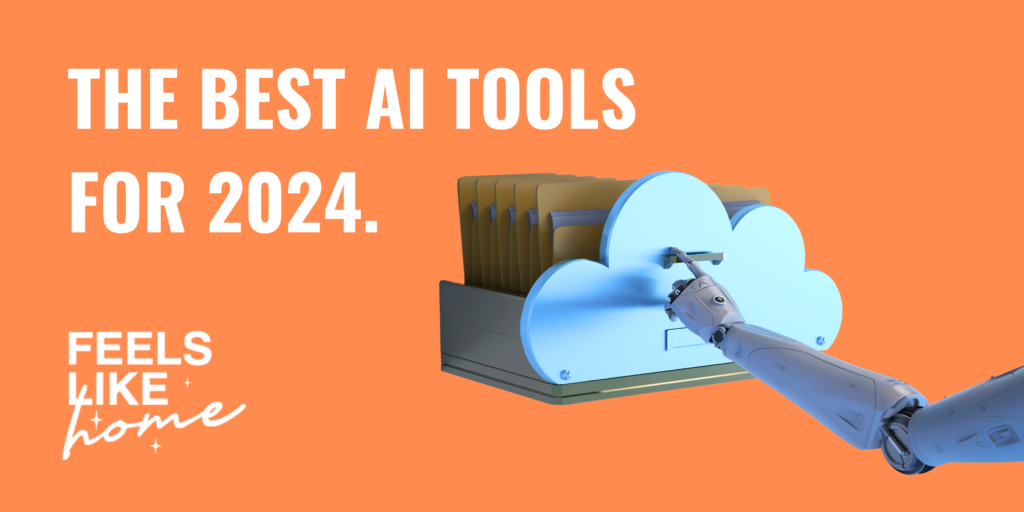
Extra, extra, read all about it… AI is changing the world and becoming a global superpower, just without the cape. And you don’t even need to be an elite Silicon Valley tech wizard to use them. With around 97% of phone users accessing AI-powered voice assistants, these tools are pretty much available to anyone. But are they friends or foes? And which AI tools are the best for 2024?

What are AI tools?
AI tools are software technologies and systems that use AI processes, techniques, and algorithms to perform tasks. They can troubleshoot problems, work with content, and help users manage daily activities. These tools automate complex processes and enhance decision-making in various industries. They enable humans to be more efficient and productive.For example, AI tools can detect fraud and perform risk assessments in finance. They can optimize production processes, monitor manufacturing equipment performance, and operate chatbots and automated voice response systems. AI tools have great potential, but in order to utilize them effectively, you need to know how they work.
How do AI tools work?
AI tools work by learning from data and using that information to perform tasks based on human intelligence processes, like pattern recognition, prediction, and decision-making. As a result, AI tools are no longer restricted to virtual assistants like Alexa; they can be integrated into practically every global industry. For example, AI tools in healthcare analyze medical images and assist doctors with diagnosis. With their assistance, doctors can identify medical concerns like cancer earlier, leading to faster, more effective treatments. But with so many AI applications out there, what are the best for 2024?

The best AI tools for 2024 – specifically for creators, are Grammarly, Quillbot, Copysmith, ChatGPT, HubSpot, Hootsuite, Lovo, Synthesia, Sonantic, Alexa and Siri, Nest Thermostat, Futurenda, Wibbitz, Descript, Kaiber.ai, Filmstro, Adobe Podcast, and Otter.ai. They assist users as AI writing tools in marketing, voice overs, everyday life, video, and audio.
Here’s a breakdown of each one.
3 best writing tools
- Grammarly is one of the best AI writing tools that functions as a personal editor that checks grammar, spelling, punctuation, and more. You can integrate the software into various applications and check all the content you create. A remote company that frequently communicates through emails can use Grammarly for error-free and professional communication.
- QuillBot is also part of the writing applications powered by AI. It’s a paraphrasing tool that rephrases sentences or paragraphs without changing the original meaning. A marketing agency can use QuillBot to create compelling ad copy for all the campaign’s advertisements, whether it’s a video ad script or a social media post.
- Copysmith is another writing application powered by AI; it generates business copy through high-quality blogs, ads, and social media posts. A company with Copysmith can create unique, engaging blog posts to attract website visitors, converting them into customers.
The marketing tools:
- ChatGPT is part of the AI marketing tools that use natural language processing (NLP) to create personalized responses to customer queries. So, e-commerce businesses can use ChatGPT for customer support and recommendations based on customers’ preferences and purchase history.
- HubSpot is a marketing automation platform that allows businesses to create and implement personalized marketing campaigns across multiple channels. A B2B software company can use HubSpot to develop email campaigns and promote new product features to existing customers.
- Hootsuite is another AI marketing tool that helps businesses track and analyze social media conversations and trends in real time. A fashion retailer can use Hootsuite to monitor fashion trends and identify industry influencers through social media.
3 best voice over tools
The following AI voice over tools aren’t just AI utilities; they are professionally recognized companies that specialize in providing AI voice over services that you can use for your audio/video projects.
- Lovo uses deep learning algorithms to mimic human speech patterns and inflections to generate natural-sounding voices for voice over projects. A small company creating online cooking tutorials can use these to generate narrations for instructional videos.
- Synthesia creates realistic, lip-synced videos with virtual characters and voice overs that work well in training videos, tutorials, and product demos. A smart home device company can create product demos with a virtual AI spokesperson and voice over.
- Sonantic creates realistic character voices for video games, animations, and other media. These voice over tools also replicate real people using vocal recordings, like Val Kilmer. When he lost his voice, Sonantic created an AI version of Val Kilmer’s voice using their software and his old vocal recordings.
3 best tools for everyday life

- Alexa and Siri are voice-activated assistants for day-to-day life. Amazon manufactured Alexa, while Apple developed Siri for iOS devices. Together, they can set reminders, schedule appointments, pay bills, play your favorite tunes, set the mood for a party, or control settings in your house like the lights or security cameras.
- Nest Thermostat is a smart home device that learns schedules and preferences to optimize home energy usage. It will automatically customize a room’s climate based on the weather, lower the heat when you leave for work, and raise it before you return.
- Futurenda is a productivity tool that manages tasks and goals, categorizing items by importance, urgency, or deadline. It also syncs data with your calendar, reminding you of upcoming events.
3 perfect tools for videos
- Wibbitz transforms text into video, with a focus on post-production. Visuals, animations, and audio elements become incredible video narratives without any inconvenient manual editing.
- Descript is a video and podcast editor. Since it automatically transcribes videos, users can edit projects through text. You can also remove filler words like ‘uh’ and ‘um,’ saving time and effort.
- Kaiber.ai helps you produce artistic videos from regular video clips, images, audio, or text. And with the ‘Transform’ tool, you can even create hyper-stylized AI video versions.
Your best friends for audio editing:
- Filmstro helps video creators make personalized soundtracks. You can adjust musical elements in real-time to align with the video’s mood and pace – making it ideal for post-production.
- Adobe Podcast makes podcast recording with remote guests a seamless process. It has built-in features for audio recording, like its ‘Enhance Speech’ button, to remove background noise and echo.
- Otter.ai is an AI-powered transcription service that generates accurate, real-time transcriptions. It works on spoken content like meetings, interviews, and lectures.
Final thoughts on AI tools
Now you know exactly which tools are available! Pick the one that’ll best save you time, streamline business operations, and even save lives. Whether you’re a writer, marketer, casting director, or just a regular person, there’s an AI tool for you. The best for 2024 range from Grammarly and QuillBot to Hootsuite, ChatGPT, Lovo, and Synthesia.
FAQs on AI tools
What tools are used to make AI?
Commonly used AI tools include programming languages like Python and R, machine learning frameworks like TensorFlow and PyTorch, and cloud-based AI platforms like Google Cloud AI and Microsoft Azure AI.
What are the most useful AI tools?
The most useful AI tools are TensorFlow, PyTorch, Keras, Scikit-learn, OpenCV, and NLTK.
What are the 4 major components of AI?
The 4 major components of AI are machine learning, natural language processing (NLP), computer vision, and robotics.
What are 3 examples of technologies that use AI?
Technologies that use AI are virtual assistants like Alexa and Siri. They’re also recommendation systems e-commerce platforms like Amazon and Netflix use and autonomous vehicles like Tesla that use computer vision and machine learning to make driving decisions.
Hoping you like it, and if you want to know how to increase your visibility just grab our free consultation, we will be happy to make your business grow.


